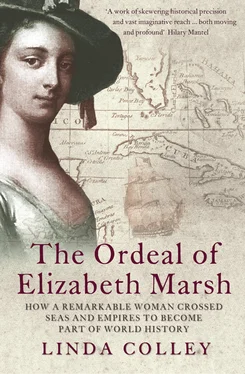1 ...7 8 9 11 12 13 ...22 Elizabeth Marsh’s early exposure in Portsmouth to the sights and sounds of difference and diversity, and simultaneously to the Royal Navy and to the force of the British state, has to be factored in if we are to understand how she came to be the person she was, and to lead the life that she did. But she was also shaped of course by her family. ‘I was the daughter of a gentleman,’ she once wrote. 51 The truth was more interesting.
While almost everything about her mother remains unclear, her father’s background is remarkably well documented. Milbourne Marsh had been christened in St Thomas church in Portsmouth in October 1709. His father, George Marsh (b.1683), was also a ship’s carpenter with the Royal Navy, which was typical enough, since shipbuilding was a closely guarded trade, customarily passed on through the males of a family over generations. Milbourne’s mother, who was born Elizabeth Milbourne in 1687, possessed her own link to the maritime, though a significantly different one. Her father, John Milbourne, ‘an excellent pen man’, was employed after 1713 as clerk to Sir Isaac Townsend, the Resident Commissioner at Portsmouth naval dockyard. 52
This blood connection with someone who worked with pen and paper was important, and the careful perpetuation of his mother’s surname in Milbourne Marsh’s own first name shows that his family was well aware of this. Both of Milbourne’s parents were literate, and both took pleasure in using words. As would be true of Elizabeth Marsh, they were compulsive storytellers. From his father, George Marsh, Milbourne heard tales about his grandfather, yet another mariner, called Francis Marsh. On a voyage from Lisbon back to Southampton in the early 1690s, this particular Marsh was wrecked off the Isle of Wight. ‘The ship and everything in it but himself were lost,’ but Francis Marsh – or so Milbourne and his siblings were told – plunged into the sea with his banknotes and valuable papers wrapped up in an ‘oil skin bag’, together with ‘a small family bible, not above 7 inches long, 4 or 5 inches broad and about 1 inch and a half thick’, and was ‘miraculously saved on shore on the beach’. Milbourne’s mother’s favourite tales were of her grandfather, a Northumberland-based dealer in Scottish cattle called John Milbourne. In May 1650, she claimed, he had risked his life hiding the Scottish royalist hero James Graham, 1st Marquess of Montrose, when he was on the run from the Scottish Covenanters who were allies of Parliament. Only when Montrose left this plain man’s sanctuary, and went seeking help from a nearby landowner, was he betrayed and handed over to his enemies and execution.
Tokens of these and other past family dramas were carefully preserved. George Marsh senior and his wife kept a print of the Marquess of Montrose on a wall in every lodging house they occupied. As for Francis Marsh’s providential Bible and prayer book, what passes for this volume still exists today, its battered pages bearing annotations by one of George Marsh senior’s sons. The content of these family legends, and the tenacity with which they were held, suggest the eagerness of Marsh family members to view themselves as something more than mere skilled artisans. Milbourne Marsh and his siblings were brought up on ‘a slender income by good management and prudence’, but the stories he and they listened to, and that he passed on in turn to his own daughter, Elizabeth Marsh, evoked a rather different status. God, these family romances proclaimed, had intervened to preserve one of their ancestors by a ‘wonderful deliverance’. Yet another ancestor had performed an act of signal service to the cause of Britain’s monarchy. Moreover, as Milbourne Marsh’s mother told her children by way of other stories, they should rightfully have been rich. Her father John Milbourne, she insisted, ‘a fine handsome person, a good scholar and of great abilities’, had once owned a colliery in Northumberland and was ‘highly esteemed by the nobility and gentry of the county’. But he lost some of his money to a nobleman (worthless aristocrats are a recurring motif in Marsh family sagas), and his housekeeper subsequently cheated her way into his bed, faked his will, and ‘got possession of the whole fortune’. 53
The moral that family members were encouraged to draw from these stories – and Elizabeth Marsh certainly grew up believing this – was that they were marked out in some fashion, and deserving of more than their immediate, circumscribed surroundings and conditions of life. The stories also reveal something else about how she grew up. Contrary to what is sometimes assumed, long-distance migration was not an aspect of the coming of modernity. Frequently, it was a practice that was learnt and adopted by a family’s members over successive generations, and that often increased in scale and duration in the process. Elizabeth Marsh’s restlessness, it is clear, was in part an inherited trait. Her father Milbourne Marsh took ship to the Caribbean, but his forebears were also sailors and migrants. His father and grandfather were mariners familiar with European waters. His mother’s family moved between northern England and Scotland, and then down to southern England. And whether Elizabeth’s own mother’s roots lay in West Africa or in England, she too must have been of voluntary or involuntary migrant stock, before sailing herself across the Atlantic to England in 1735.
From Milbourne Marsh’s family – and perhaps from her mother’s – Elizabeth Marsh also inherited good looks and physical toughness. Milbourne’s father, George Marsh senior, was described as a ‘remarkable fine person’, ‘upwards of six feet high … very upright and well proportioned, [and] amazingly strong and healthy’. Although the Navy Board awarded him a pension in the mid-1740s, he seems to have continued working part-time as a shipwright, and was seventy when he was killed in an industrial accident in 1753. 54 Married in 1707, he and Elizabeth Milbourne produced nine children and, unusually for their time and social level, eight of them reached adulthood. What were then untreatable diseases, and maritime accidents, killed off five of these Marsh progeny before they reached the age of forty, but the life spans of the remaining three confirm a family tendency towards physical vigour and good health. Milbourne Marsh (b.1709) lived to be almost seventy; George Marsh the younger (b.1722) made seventy-eight; while their sister Mary Marsh (b.1712) reached her eighties. It is striking too how, in different ways, and in conformity with the family’s stock of stories, all three of these longer-lived Marsh siblings constructed for themselves richer, more varied existences than their parents. Even Mary Marsh’s life, hampered by her gender, illustrates this. Once in her teens, she went to London to find work, and married a French Huguenot, Jean Duval. He worked as a baker in Spitalfields, a once semi-rural suburb in the east of London that has always attracted a disproportionate number of refugees and immigrants. This alliance with a family of French origins, attached to another form of Protestantism, made more than Mary’s own life more diverse. Visits to aunt Mary and uncle Duval in London in the 1740s and early ’50s seem to have allowed Elizabeth Marsh to learn to speak and read French, one of the prime accomplishments that normally connoted gentility. 55
The ‘industrious revolution’, as the marked changes in family aspirations at this time have been called, a rising level, throughout Europe and North America and possibly beyond, of individual and clan desire, expectations, and household expenditure, also affected Milbourne Marsh, and to a more spectacular degree his brother, George Marsh the younger. 56 The temperaments and changing fortunes of these two men, Elizabeth Marsh’s father and her uncle, are important because both men played crucial roles in her development, influencing what she came to be, and what she came to do.
Читать дальше












